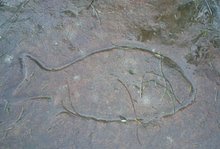
A whale was sighted today at 4.15 pm leaving the Heads and racing north. It stayed closely hugged to North Head cliffs and seemed in a big hurry. The buzzing helicopter continuously encircling the headland might have contributed to the mammal' s exit.
At first a large long shade was visible in the water, then the plume from time to time and then it hurried along the cliff face and I heard a loud exhaling sound once. The back was very arched while it sped out to the open ocean.
These big-brained, breathing mammals, giving birth to live young, might have be on their traditional migration routes for the last 15 - 36 million years.
In some of the last thousands of years the aquatic mammal to land mammal relationship is well documented. Various engravings in the region of whales and tales by the saltwater people speak of custodianship. The first encounters of British and Saltwater people also involved a whale at North Head (Car-rang-gel) (The tale of a whale: significant Aboriginal landscapes of the Northern Beaches, Lee, Emma, 1973)
The utilisation of the animals as cheap oil led settlers to resort to whaling over a long time. The Right Whale was named the 'right' whale, because it was easy to hunt. The animal was not just reduced to tonnes of blubber, but also served as an icon in the Western mind. Moby Dick (here the book) presented the (white) whale as the "metaphor for the elements of life that are out of our control". A big job in colonial empires, terrestrial or aquatic.
Now there is a 'scientific' need for the cetaceans which this time round turns them not into oil, but kebabs. The spectacle-hungry audiences in powerful boats also are impinging on the whale's habitat. The whale industry is re-born: 'whale-watching'.
For eons the whales have undertaken one of the longest journeys of any animal in the world. After feeding in the Antarctic waters, they migrate along the coast of Australia between June and August to meet up. 8 hours sleep, harbours and bays would provide a good rest, specifically when young ones are in the pod.
Engaging in playful behaviour, such as breaching, spyhopping or tail slapping is typical for them. They are vivid communicators. They sing songs to each other, The Humpback Whale song is reminiscent of human singing. The Killer Whale still has that bit of wolf-sound left.
Collaborative food acquisition such as 'bubblenet feeding' is a specialty of the Humpback.
Well, today's whale had the double plume of a Southern Right Whale, but the dorsal fin of a Humpback and it vocalized and I'm happy IT is there.
So, do not hassle them on the water, or trample the bush to bits and say NO to whaling. They are wonderful giants and they are still here….
manly whales Sydney Harbour
28 July 2005
Whales
Subscribe to:
Post Comments (Atom)











No comments:
Post a Comment